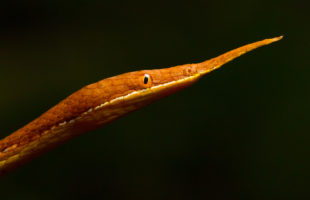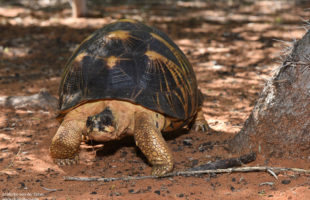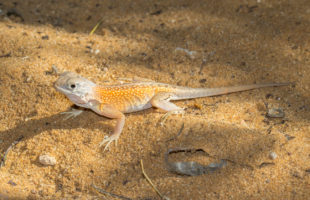Ihre Gesänge gehören zu den eindruckvollsten, die die Tierwelt zu bieten hat: Man kann die Stimmen der Indris (Indri indri) kilometerweit durch den Wald schallen hören, und sie tragen eine eigentümliche Traurigkeit mit sich. Angeführt und begonnen wird der Gesang stets vom Elternpaar einer Familie, das damit sein Revier absteckt, aber auch mit anderen Familien kommuniziert und vor Bedrohungen wie …
LesenSchlagwort-Archiv: endemic
The second smallest reptile on Earth
It can sit on a matchstick without a problem, and you could almost think that the slightest breeze will blow the fragile pipsqueak off the match: Brookesia micra, the second smallest* reptile on Earth. Despite its few millimeters body lengths, the little, brown leaf chameleon has everything other chameleons need for life, too: Eyes moving to every possible direction, a …
LesenAgainst the tide: A climbing Mantella
Actually, Madagascan Mantellae all look very similar: Striking colours, small and slender, terrestrial frogs. But one steps out the line: The climbing Mantella (Mantella laevigata). This Mantella was described in 1913 by British zoologists Paul Ashleyford Methuen and John Hewitt, who did a seven months lasting expedition to Madagascar two years ago. The climbing Mantella grows up to maximally 29 …
LesenThe carnivore among plants
Carnivorous plants in Madagascar? Yes, there are! Two species of pitcher plants (Nepenthes madagascariensis and Nepenthes masoalensis) solely exist on the big island. You can find them in open, sunny areas on humid sandy soil along Madagascar’s east coast. In northern direction, they occur until Antongil bay and in southern direction until Tolagnaro (French Fort Dauphin). Mostly, large populations are …
LesenThe left-handed lemurs: Coquerel’s sifakas
With their typical teddy bear-like appearance, they wrap many travellers around their fingers: Coquerel’s Sifakas (Propithecus coquereli) wear a plush, snow-white fur, whereby the upper sides of the arms and thighs as well as the chest are deeply chocolate brown colored. With up to a half meter head-torso-length – in addition, another half meter tail – as well as approximately …
LesenThe Malagasy leaf-nosed snake
A nose that somehow resembles a frayed leaf and can be bent, and an elongated body: these are the most outstanding characteristics of the Langaha madagascariensis, one of many bizarre animals in Madagascar. The purpose of the bizarre nasal process has not yet been clarified. In males, it looks more like a Pinocchio nose than a leaf. The name of …
LesenClad in armour but hardly protected: The Radiated Tortoise
They have not changed for millions of years and still fascinate people all over the world: tortoises. A particularly beautiful species lives in the south of Madagascar: the Radiated Tortoise (Astrochelys radiata). Its history begins long, long before the first people came to Madagascar. But it was not until 1802 that the Englishman George Shaw described the Radiated Tortoise. He …
LesenLife in drought and heat – The Malagasy collared lizard
Only few animals can survive in Madagascar’s dry, hot south for long. One of them is the Madagascar sand lizard (Chalarodon madagascariensis). Madagascar has no large iguanas like you probably know iguanas from America. Instead the local iguanas are rather small, agile and swift – they are so special, that they got their own family, which exists nowhere else on …
LesenLife in colour: panther chameleons
Panther chameleons (Furcifer pardalis) belong to the most famous inhabitants of Madagascar and regularly populate the coastal areas of northwest Madagascar, across the north and on the east coast down to about 120 kilometres south of Toamasina (Tamatave). There seem to be no particular favourites among the populated habitats, even if one sees them particularly well in open, bush-covered areas. …
LesenThe Malagasy Tree Boa
Saying of many ages and fairy tales she has a dubious reputation, but actually she is a fascinating forest dweller: The Malagasy Tree Boa. There are two species of Tree Boa in Madagascar. The species Sanzinia madagascariensis lives mainly in the rainforests of the east coast of Madagascar. The second species, Sanzinia volontany, has conquered other habitats such as the …
Lesen MADAMAGAZINE Your Magazine about Madagascar
MADAMAGAZINE Your Magazine about Madagascar










